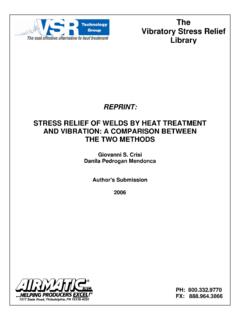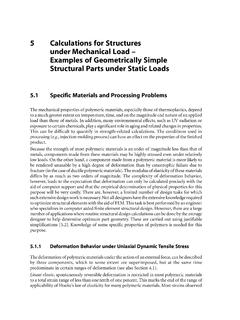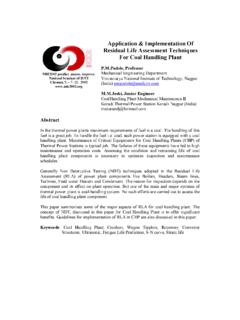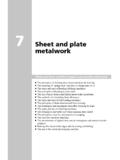Transcription of The Vibratory Stress Relief Library
1 PH: FX: The LibrarVibratory Stress Reliefy REPRINT: Vibratory Stress Relief : A FUNDAMENTAL STUDY OF ITS EFFECTIVENESS R. Dawson D. G. Moffat Published in Journal of Engineering Materials and Technology April, 1980 Reprinted from April, 1980, Vol. 102, Journal of Engineering Materials and Technology Journal of Engineering Materials and Technology APRIL 1980, Vol. 102/169 Vibratory Stress Relief : A Fundamental Study of Its Effectiveness R. DawsonGroup Purchase DepartmentPerkins Engines Limited,PeterboroughD. G. MoffatDepartment of Mechanical Engineering,University of Liverpool,Liverpool, England Techniques have been devised for inducing consistent residual Stress distributionsinto cantilever beams and for measuring their variation through the Vibratory Stress Relief procedures have been simulated using a laboratory shaker, and it has been shown that resonant vibration techniques arecapable of producing almost complete surface Stress Relief in specimens of hot rolledmild steel, cold drawn mild steel, and an aluminium alloy.
2 The variables involved in the process are examined and conclusions are reached regarding cyclic strain am-plitudes, cycle numbers, and frequency and fatigue effects. Introduction Vibratory Stress Relief ( ), as an alternative to natural ageing or thermal Stress Relief for reducing residual stresses in structures, has been debated for some 35 years. Investigations have ranged from tests on simple fatigue type specimens [1-3], with residual stresses induced by shot-peening or plastic bending, to vibration tests on castings and weldments [4-11]. Commercial processes normally involve clamping an ec-centric-mass electric motor to the work-piece and vibrating at various resonant frequencies for periods of the order of 15 minutes. Manufacturers claim to achieve greatly increased dimensional stability during machining and subsequent operation of castings and weldments, up to many tons in weight, as a result of applying the process.
3 The evidence that the process does indeed produce increased dimensional stability is impossible to deny. However, the various research investigations, aimed at assessing and ex- plaining the process, have arrived at a variety of conclusions ranging from open skepticism to guarded optimism. Early work by McGoldrick and Saunders [4] on castings and welded space frames, although giving no useful quan-titative data, concluded that vibrational Stress Relief depended upon the occurrence of plasticity at some time during the treatment, and that to achieve the necessary amplitudes, resonant vibration should be used. These conclusions were supported by the findings of Moore [1] using shot-peened tapered cantilever beams. In the early 1960's, Buhler and Pfalzgraf contributed four papers [6 and 12-14] on the subject, describing tests on a variety of castings and weldments.
4 Their conclusions were not encouraging, although they did achieve a 20 percent reduction in residual Stress when they increased the applied cyclic Stress to around the fatigue limit of the steel used. They were clearly restricted by their concern about potential fatigue failures, and hence never attained the Stress amplitudes that would be required for significant Stress Relief . Adoyan, et al. [7 and 8] Contributed by the Materials Division for Publication in the JOURNAL OF ENGINEERING MATERIALS AND TECHNOLOGY. Manuscript received by the Materials Division, August 20, 1979. showed that long term stability of iron castings was much improved as a result of a vibration treatment although, like Buhler and Pfalzgraf, they were concerned about the possible failure of their castings during the vibration process.
5 They proposed a combined annealling and vibration treatment to overcome this problem. Lokshin [9] obtained up to 70 percent Stress relaxation in preloaded cast aluminium rings with a resonant cyclic Stress superimposed. In 1971 Sagalevich and Meister [15] claimed success using an eccentric-mass type of vibrator in producing 50 percent reductions in welding deformations in wagon bodies fabricated from welded sheet steel. Probably the most useful literature on the subject to date is that produced by Wozney and Crawmer [10]. They achieved a 33 percent reduction in residual Stress in a shot-peened Almen strip 3 x x in. (76 x 19 x mm) thick subjected to cyclic bending between fixed strain limits. The value of their work was that they gave a plausible explanation of the behavior in terms of the cyclic softening characteristics of the material.
6 According to the known monotonic tensile yield strength of the Almen strip, yielding would not have been anticipated during the application of cyclic loading. However, using a derived cyclic Stress -strain curve for the material they showed that, with a knowledge of the initial residual Stress magnitude, the applied cyclic Stress amplitude and the final strain condition, they could predict the residual Stress reduction. Brogden [16] conducted a literature survey of the work prior to 1968. His conclusions as to the value of the process were largely pessimistic. He was not convinced that dimen- sional stability could be achieved without serious risk of fatigue failure during vibration. In 1972, Cheever [11] described an extensive investigation on the subject, conducted at the Battelle Memorial Institute.
7 Initially, a series of small scale specimens including flame-hardened castings, welded rings, welded T-beams, welded boxes and welded plates were vibrated on a vibration table using a variety of gripping techniques. The welded rings and T-beams gave the most promising results initially, but on further investigation the additional results were found to be 170/Vol. 102, APRIL 1980 Transactions of the ASME Table 1 Material properties Material Proof Stress lbf/in2 (MN/m2 Ultimate tensile Strength lbf/in2 (MN/m2) Hot-rolled mild steel Cold-drawn mile steel Aluminium alloy 41,500 (290) 88,000 (607) 37,600 (262) 57,000 (393) 88,500 (610) 40,200 (277) either discouraging or inconclusive. Very little information was given on the applied cyclic Stress levels, although it was implied that the values were low.)
8 These tests were followed by a series of tests on a variety of large scale castings and also 24 large valve rings with stiffening ribs. Unfortunately, the scatter in the results prevented the author from reaching firm conclusions on the effects of on dimensional stability. The overall conclusions were disappointing, bearing in mind the extensive scale of the investigation. Recent work by Weiss, et al. [17) using 12 in. (306 mm) diameter by in. (12 mm) thick low carbon steel discs with a 6 in. (103 mm) diameter submerged arc weld, reported substantial reduction in residual welding Stress . The specimens were vibrated on a large laboratory shaker and residual stresses were measured using a modified Sachs boring-out technique. It will be seen from the above summary of previous work on the subject that, although there has been a considerable effort expended over the years, the pros and cons of the technique are still very much under debate.]
9 The researchers are undecided on the whole, and yet many manufacturers claim to be using the technique with positive results. A recent article by Dreger [18] summarizes the manufacturers' claims for the process as follows: "The Vibratory method of relieving stresses in castings and weldments does the job faster, cheaper, and more conveniently than thermal Stress relieving." The objectives of the present work were to examine as many of the variables in the process as possible, without the complication of welds or complex castings. To do this simple test specimens were required within the following constraints: (a) Specimens should be readily available in a range of metals as standard stock; (b) For each material, it should be possible to introduce a residual Stress distribution that would be consistent from one specimen to another; (c) The residual Stress should be capable of being reliably measured; (d) Specimens should be capable of being vibrated in a manner that would relate as nearly as possible to the com-mercial process.
10 This means that dimensional changes during vibration should be unrestrained; (e) Cyclic Stress amplitude and frequency should be variable and readily controlled. The specimen design selected and the test methods adopted to achieve the above objectives, together with the results and conclusions, are now discussed. Simulation of the Process The test specimen and vibration technique selected are indicated schematically in The test specimen is a simple cantilever beam of in. (12 mm) square cross-section with residual stresses induced by plastic bending. The test beam, together with an as-supplied control beam, were clamped to an electromagnetic shaker as indicated, and resistance strain gauges were used for control of the vibration and measurement of residual stresses.









